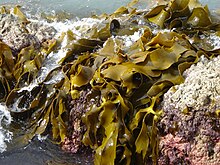

Phlorotannins are a type of tannins found in brown algae such as kelps and rockweeds[1] or sargassacean species,[2] and in a lower amount also in some red algae.[3] Contrary to hydrolysable or condensed tannins, these compounds are oligomers of phloroglucinol[4] (polyphloroglucinols).[5] As they are called tannins, they have the ability to precipitate proteins. It has been noticed that some phlorotannins have the ability to oxidize and form covalent bonds with some proteins. In contrast, under similar experimental conditions three types of terrestrial tannins (procyanidins, profisetinidins, and gallotannins) apparently did not form covalent complexes with proteins.[6]
These phenolic compounds are integral structural components of cell walls in brown algae, but they also seem to play many other secondary ecological roles such as protection from UV radiation and defense against grazing.
- ^ Van Alstyne, Kathryn L.; McCarthy, James J.; Hustead, Cynthia L.; Kearns, Laura J. (1999). "Phlorotannin Allocation Among Tissues of Northeastern Pacific Kelps and Rockweeds" (PDF). Journal of Phycology. 35 (3): 483. Bibcode:1999JPcgy..35..483V. doi:10.1046/j.1529-8817.1999.3530483.x. S2CID 84608425. Archived from the original (PDF) on 2010-06-19.
- ^ Kamiya, Mitsunobu; Nishio, Takeshi; Yokoyama, Asami; Yatsuya, Kousuke; Nishigaki, Tomokazu; Yoshikawa, Shinya; Ohki, Kaori (2010). "Seasonal variation of phlorotannin in sargassacean species from the coast of the Sea of Japan". Phycological Research. 58: 53. doi:10.1111/j.1440-1835.2009.00558.x. S2CID 83823009.
- ^ http://eurekamag.com/research/011/190/presence-lectins-tannins-protease-inhibitors-venezuelan-marine-algae.php
- ^ Shibata, Toshiyuki; Kawaguchi, Shigeo; Hama, Yoichiro; Inagaki, Masanori; Yamaguchi, Kuniko; Nakamura, Takashi (2004). "Local and chemical distribution of phlorotannins in brown algae". Journal of Applied Phycology. 16 (4): 291. Bibcode:2004JAPco..16..291S. doi:10.1023/B:JAPH.0000047781.24993.0a. S2CID 13479924.
- ^ Ragan, Mark A.; Jensen, Arne (1978). "Quantitative studies on brown algal phenols. II. Seasonal variation in polyphenol content of Ascophyllum nodosum (L.) Le Jol. And Fucus vesiculosus (L.)". Journal of Experimental Marine Biology and Ecology. 34 (3): 245. Bibcode:1978JEMBE..34..245R. doi:10.1016/S0022-0981(78)80006-9.
- ^ Stern, J. Lewis; Hagerman, Ann E.; Steinberg, Peter D.; Mason, Pamela K. (1996). "Phlorotannin-protein interactions". Journal of Chemical Ecology. 22 (10): 1877–99. Bibcode:1996JCEco..22.1877S. doi:10.1007/BF02028510. PMID 24227114. S2CID 11031529.